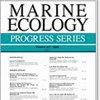Acoustic telemetry captures the full annual migration of alewife between Chesapeake Bay and the Gulf of Maine
IF 2.1
3区 环境科学与生态学
Q2 ECOLOGY
引用次数: 0
Abstract
ABSTRACT: Anadromous fish are declining at a global scale, and a more holistic approach to management is needed that addresses threats across their freshwater, estuarine, and ocean habitats. In this study, we used acoustic telemetry to track adult alewife Alosa pseudoharengus in Chesapeake Bay, USA, to evaluate, for the first time, habitat use throughout the entire annual migration cycle. Fifty adult alewife were tagged in the Choptank River, Maryland, in spring 2022, and detection data were obtained via collaborative acoustic telemetry networks along the Eastern Seaboard of the USA and Canada. Water temperature data were also collected using data loggers in the Choptank River and from satellite measurements of sea surface temperature in Chesapeake Bay and the ocean. In total, 48 tags (96%) were detected at least once, 14 tagged fish (28%) were detected in the ocean migrating north to the Gulf of Maine and Bay of Fundy, and 5 tagged fish (10%) returned to the Choptank River in spring 2023. With few exceptions, tagged fish were detected at temperatures of 7-16°C across all habitats (river to ocean and back). Alewife made extensive use of tidal and non-tidal portions of the Choptank River during spring, migrated to summer habitats that are experiencing rapid warming, and passed through areas of high incidental catch on both the outgoing and return migration. This study highlights how acoustic telemetry can refine our understanding of river-specific migrations of anadromous fish and the management implications of their movements in regions with collaborative acoustic telemetry networks.声学遥测技术捕捉到切萨皮克湾和缅因湾之间金线鱼的整个年度洄游过程
摘要:溯河产卵鱼类正在全球范围内减少,因此需要一种更全面的管理方法来应对其淡水、河口和海洋栖息地所面临的威胁。在这项研究中,我们利用声学遥测技术追踪了美国切萨皮克湾的成年金线鱼(Alosa pseudoharengus),首次评估了整个年度洄游周期中栖息地的使用情况。2022 年春季,在马里兰州乔普坦克河(Choptank River)对 50 条成年金目鲷进行了标记,并通过美国东部沿海和加拿大的合作声学遥测网络获得了探测数据。此外,还利用 Choptank 河的数据记录器以及切萨皮克湾和海洋的海面温度卫星测量数据收集了水温数据。总共有 48 个标签(96%)至少被检测到一次,14 个标签鱼(28%)在向北洄游到缅因湾和芬迪湾的海洋中被检测到,5 个标签鱼(10%)在 2023 年春季返回 Choptank 河。除少数例外,在所有栖息地(从河流到海洋再到海洋)都能检测到温度为 7-16°C 的标记鱼。金线鱼在春季广泛利用了 Choptank 河的潮汐和非潮汐部分,洄游到正在经历快速变暖的夏季栖息地,并在出游和回游过程中经过了意外捕获量较高的区域。这项研究强调了声学遥测技术如何完善我们对溯河鱼特定河流洄游的了解,以及在拥有协作声学遥测网络的地区对溯河鱼洄游的管理影响。
本文章由计算机程序翻译,如有差异,请以英文原文为准。
求助全文
约1分钟内获得全文
求助全文
来源期刊

Marine Ecology Progress Series
环境科学-海洋学
CiteScore
5.30
自引率
8.00%
发文量
238
审稿时长
3 months
期刊介绍:
The leading journal in its field, MEPS covers all aspects of marine ecology, fundamental and applied. Topics covered include microbiology, botany, zoology, ecosystem research, biological oceanography, ecological aspects of fisheries and aquaculture, pollution, environmental protection, conservation, and resource management.
 求助内容:
求助内容: 应助结果提醒方式:
应助结果提醒方式:


